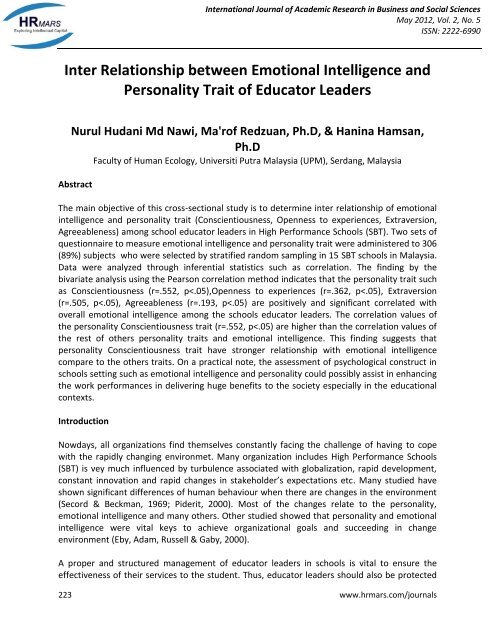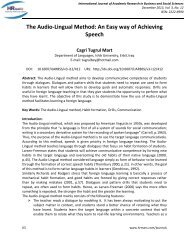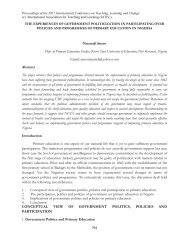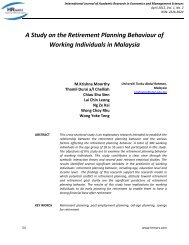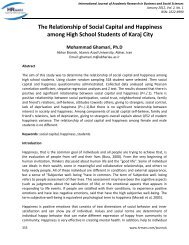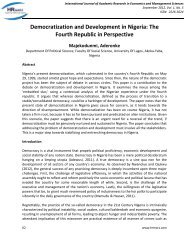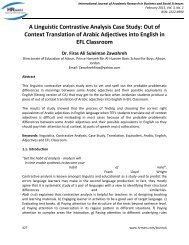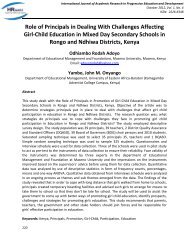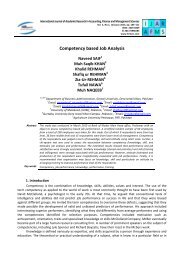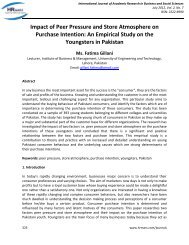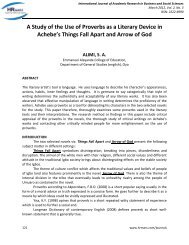Inter Relationship between Emotional Intelligence and Personality ...
Inter Relationship between Emotional Intelligence and Personality ...
Inter Relationship between Emotional Intelligence and Personality ...
Create successful ePaper yourself
Turn your PDF publications into a flip-book with our unique Google optimized e-Paper software.
<strong>Inter</strong>national Journal of Academic Research in Business <strong>and</strong> Social Sciences<br />
May 2012, Vol. 2, No. 5<br />
ISSN: 2222-6990<br />
<strong>Inter</strong> <strong>Relationship</strong> <strong>between</strong> <strong>Emotional</strong> <strong>Intelligence</strong> <strong>and</strong><br />
<strong>Personality</strong> Trait of Educator Leaders<br />
Nurul Hudani Md Nawi, Ma'rof Redzuan, Ph.D, & Hanina Hamsan,<br />
Ph.D<br />
Faculty of Human Ecology, Universiti Putra Malaysia (UPM), Serdang, Malaysia<br />
Abstract<br />
The main objective of this cross-sectional study is to determine inter relationship of emotional<br />
intelligence <strong>and</strong> personality trait (Conscientiousness, Openness to experiences, Extraversion,<br />
Agreeableness) among school educator leaders in High Performance Schools (SBT). Two sets of<br />
questionnaire to measure emotional intelligence <strong>and</strong> personality trait were administered to 306<br />
(89%) subjects who were selected by stratified r<strong>and</strong>om sampling in 15 SBT schools in Malaysia.<br />
Data were analyzed through inferential statistics such as correlation. The finding by the<br />
bivariate analysis using the Pearson correlation method indicates that the personality trait such<br />
as Conscientiousness (r=.552, p
<strong>Inter</strong>national Journal of Academic Research in Business <strong>and</strong> Social Sciences<br />
May 2012, Vol. 2, No. 5<br />
ISSN: 2222-6990<br />
against too much physical <strong>and</strong> emotional burden while facing organizational change such as in<br />
policy, communication technology, constant innovation, globalization as well as in education<br />
system itself. In this changing process, educator leaders are constantly under pressure to find<br />
new <strong>and</strong> good solutions, which will preserve future competitiveness.<br />
Educator leaders should try to survive <strong>and</strong> remain competitive, so that they are reorganizing,<br />
reimplementing <strong>and</strong> restructure a new approach. In other words, they constantly try to face the<br />
changes in order to fulfill the recognization <strong>and</strong> at the same time need to be sustainable in the<br />
competititive environment to continuously improve the changing conditions to enchance<br />
education system in Malaysia. These ongoing <strong>and</strong> seemingly endless efforts can put a lot of<br />
strain not only on school organization but also on individual. According to Beer <strong>and</strong> Nohria<br />
(2000) argue that 70 per cent of changes process fail because of lack of strategy <strong>and</strong> vision, lack<br />
of communication <strong>and</strong> trust, lack of top management (leaders), resistance to change etc that<br />
will effect the individual work performance. The key factor for school organizations to compete<br />
<strong>and</strong> sustain themselves is emotional <strong>and</strong> personality.<br />
Therefore, the tolerance towards the emotional aspects of educator leaders work, in turn, can<br />
be influenced by a person’s characteristics such as emotional intelligence (EI) <strong>and</strong> trait<br />
personality on work performance. As the educator leaders in an organized group, like other<br />
profit oriented employees, it was require appropriate management. The need for good<br />
management comes from the fact that teacher profession can be cost-effective, but not costfree.<br />
Thus, effective management of the people in school organizations can help minimize cost,<br />
<strong>and</strong> ensuring the continuity of good service to the schools institution.<br />
By pooling available resources, people can do much more than they can do alone. That is why<br />
there is a need to mobilize individuals in an organized manner especially in psychological<br />
construct. To manage educator leaders professionally, much like the human resource<br />
department in many organizations, the educator leaders in school institution needs<br />
professional input especially from scholars <strong>and</strong> researchers in order to underst<strong>and</strong> how to<br />
produce a high quality of work performances. Additionally, when it comes to improve<br />
organizational effectiveness <strong>and</strong> enhance work performances, management from education<br />
scholars, intellectual discourse, <strong>and</strong> practitioners are beginning to emphasize the importance of<br />
a educator leader’s emotional intelligence (EQ) <strong>and</strong> personality traits in order to achieve high<br />
work performance.<br />
Issue of study<br />
Educator leaders are important to the schools institution that makes a schools organization<br />
successful, at the sama time they embedded in a complex educational changes. The change of<br />
system constantly threatens their ability to function well because competitive <strong>and</strong> harsh<br />
working environment will bring negative impact on them. These can lead to emotional<br />
outburst.<br />
When goverment was implemented High School Performances programme (SBT), educator<br />
leaders facing a lof of autonomy changes such as in organizing, reschedule <strong>and</strong> implement<br />
224 www.hrmars.com/journals
<strong>Inter</strong>national Journal of Academic Research in Business <strong>and</strong> Social Sciences<br />
May 2012, Vol. 2, No. 5<br />
ISSN: 2222-6990<br />
various programme - how to get things done in a timely <strong>and</strong> effective way. In other words, this<br />
situation indicates that leader need to show their ability when school institution facing all<br />
these changes <strong>and</strong> its needs some appropriate psychological construct such as emotional<br />
intelligence <strong>and</strong> personality. Besides, the problems of implementation all these things, the<br />
really issues is about how leaders influences their behaviour such as emotional intelligence <strong>and</strong><br />
personality trait in order to enhance work performance. Therefore, it is imperative study such<br />
as this is carried out to help identify these factors in specifically that influence them to be<br />
engaged in organised manner to produce good quality of performances. Therefore the<br />
objective of this study is to determine the relationship <strong>between</strong> emotional intelligence <strong>and</strong><br />
personality trait (Conscientiousness, Openness to experiences, Extraversion, Agreeableness).<br />
Literature Review<br />
<strong>Emotional</strong> <strong>Intelligence</strong><br />
The concept of emotional intelligence was firstly introduced by Salovey & Mayer (1990) as<br />
three adaptive abilities namely the ability (1) to appraise <strong>and</strong> express emotion, (2) to regulate<br />
emotions, <strong>and</strong> (3) to utilize emotions in solving problems. The first two abilities apply to oneself<br />
<strong>and</strong> others. Another definition contains an elaboration of the components of appraisal <strong>and</strong><br />
utilizing emotion. <strong>Emotional</strong> intelligence is said to refer to “an ability to recognize the meanings<br />
of emotions <strong>and</strong> their relationships, <strong>and</strong> to reason <strong>and</strong> problem-solve on the basis of them”<br />
(Mayer, Caruso & Salovey, 2000). Their model of emotional intelligence involves four branches<br />
namely ‘reflectively regulating emotions’, ‘underst<strong>and</strong>ing emotions’, ‘assimilating emotion in<br />
thought’ <strong>and</strong> ‘perceiving <strong>and</strong> expressing emotion’.<br />
Other models also offer different numbers of EI component. The model by Dulewicz <strong>and</strong> Higgs<br />
(1999) has seven components (self-awareness, emotional resilience, motivation, interpersonal<br />
sensitivity, influence, intuitiveness, <strong>and</strong> conscientiousness <strong>and</strong> integrity).<br />
On the other h<strong>and</strong>, Daniel Goleman who was responsible to popularize the term emotional<br />
intelligence. According to Goleman (1995 & 1998), emotional intelligence is an important factor<br />
in determining personal success as a student, teacher, parent, manager, <strong>and</strong> leader. However,<br />
hard evidence on the link <strong>between</strong> emotional intelligence <strong>and</strong> leadership is sparse (Higgs &<br />
Aitken, 2003; Palmer, Walls, Burgess & Stough, 2001). This paucity can be attributed to, among<br />
other, the differing ways of conceptualizing emotional intelligence. Petrides <strong>and</strong> Furnham<br />
(2000) listed three main models namely hierarchical model, (cognitive) ability model, <strong>and</strong> mixed<br />
models (personality variables plus cognitive ability). It is in the same publication that Petrides<br />
<strong>and</strong> Furnham distinguish trait EI from information-processing EI.<br />
Finally, Bar On (1997) has placed emotional intelligence in the context of personality theory. He<br />
defined emotional intelligence as an umbrella concept of non –cognitive capabilities,<br />
competencies <strong>and</strong> skill, which helps an individual to become more efficient in coping with<br />
environmental dem<strong>and</strong>s <strong>and</strong> pressures. He proposed a model of non-cognitive intelligences<br />
that includes five broad areas of skills or competencies, more specific skills that appear to<br />
225 www.hrmars.com/journals
<strong>Inter</strong>national Journal of Academic Research in Business <strong>and</strong> Social Sciences<br />
May 2012, Vol. 2, No. 5<br />
ISSN: 2222-6990<br />
contribute to success. These include intra-personal skills, inter-personal skills, adaptability,<br />
stress managemant, <strong>and</strong> general mood (optimisim happiness).<br />
In the recent year, the most appropriate method of measuring emotional intellgence is<br />
currently an area of controversy. Because there are many conflicting emotional model, it is not<br />
easy work to describe emotional intelligence, the proximal roots of which lie in the work of<br />
Gardner, (1983), <strong>and</strong> more specifically in his concept of intrapersonal <strong>and</strong> interpersonal<br />
intelligence (Mayer, Salavey & Caruso, 2004), Petrides, Frederickson & Furhnam, 2004). Based<br />
on discussion above, emotional intelligence is characterised by some researchers as an ability,<br />
involving the cognitive processing of emotional information, which is accordingly most<br />
appropriately measured by performances test. An alternative proposal is that emotional<br />
intelligence should be regarded as a dispositional tendency like personality which can be<br />
assessed by self-report questionnaire.<br />
Therefore, there has been an interesting interest in the theoritical development of the concept<br />
of emotional intelligence in an attempt to identify wheather or not this newly introduced<br />
concept accounts for variance not already accounted for by intelligence <strong>and</strong>/or personality (Fox<br />
& Spector, 2000; Van der Zee et al, 2002) in various human transactions. Thus, it is not currently<br />
clear if emotional intelligence actually assess the same constuct, <strong>and</strong> in this context Petrides<br />
<strong>and</strong> Fruhnam (2001) have suggested the terminology ‘ability EI’ <strong>and</strong> ‘trait EI” to distinguish the<br />
two measurement approaches. Ability EI or cognitive-emotional ability refers to one’s actual<br />
ability to recognize, process <strong>and</strong> utilize emotion-laden information. Meanwhile trait EI refers to<br />
self-perceptions concerning ones’ ability to recognize, process <strong>and</strong> utilize emotion-laden<br />
information. Petrides <strong>and</strong> Furhnam (2003) further stated that ability <strong>and</strong> trait EI are different<br />
construct, but that their theoretical domain may overlap.<br />
Recent debates on EI have focused largely on whether trait EI measured by self- report tests<br />
has predictive power over above traditional personality traits. The results of several studies<br />
have indicated that trait EI might be a valid constuct in the prediction of life satisfaction,<br />
somatic complaints, rumination <strong>and</strong> coping styles (Kluemper, 2008; Petrides, Pita & Kokkinaki,<br />
2007). However, the ability of trait EI in an academic setting is still unclear (Tok & Morali, 2009;<br />
Barchard, 2003). Consistent say that emotional intelligence as a construct has been showed to<br />
be an independent construct from personality (Caruso, Mayer & Salovey, 2002; McCrae, 2000;<br />
Zadal, 2004; Vakola, Tsaousis & Nikolauo, 2004; Shulman & Hemeenover, 2006). Those<br />
researchers used an ability <strong>and</strong> trait measure of emotional intelligence <strong>and</strong> 16PF as personality<br />
measure. However, Higgs (2001) found a positive correlation <strong>between</strong> emotional intelligence<br />
<strong>and</strong> the function of Intuition, but not Feeling, in Myer-Briggs Type Indicator. This findings show<br />
that the relationship <strong>between</strong> emotional intelligence <strong>and</strong> personality is still far from clear.<br />
For the current study, the authors retained the original items for translation Malay Language.<br />
The translation work was done to suit the scale for the student participants <strong>and</strong> more<br />
importantly, for future use in the general local population. Therefore, the definition of<br />
emotional intelligence is the same as adopted by Goleman (2001). The construct is<br />
operationally defined as the score on the EI scale developed by Goleman (2001).<br />
226 www.hrmars.com/journals
<strong>Inter</strong>national Journal of Academic Research in Business <strong>and</strong> Social Sciences<br />
May 2012, Vol. 2, No. 5<br />
ISSN: 2222-6990<br />
Trait <strong>Personality</strong> (Five Factor Model of <strong>Personality</strong>)<br />
<strong>Personality</strong> is a set of psychological traits <strong>and</strong> mechanism within the individual which was<br />
organized, relatively endured <strong>and</strong> influenced his or her interaction with the adaptation to the<br />
envirionment (Pevin & John, 2001). It consists of dynamic oragnization triats that determine<br />
how a person adjust himself uniquely to those environment includes seven categories;<br />
biosphyisal, biocosial, unique, integrative, adjustment, differentaite essential <strong>and</strong> omnibus<br />
(Alport,, 1961).<br />
Consensus is emerging that a five-factor model of personality can be used to describe the most<br />
salient aspects of personality (Goldberg, 1990). The Big Five is the commonly used term for the<br />
model of personality which decribes the five fundamental factors of our personality. It<br />
combines the emotion, attitude <strong>and</strong> behaviour of the people. It was defined as consistent<br />
pattern of thought, feelings or actions that distinguish people from one another (Huffman,<br />
2007). According to McCrae <strong>and</strong> Costa (1987), there are five factor models which are<br />
extraversion, agreeableness, conscientiousness, neuroticism <strong>and</strong> openness to experience.<br />
Extroverts are often competitive in nature <strong>and</strong> higly involved in many social circles <strong>and</strong><br />
activities. It includes traits such as sociability, assertiveness <strong>and</strong> talkativeness. Extraversion is<br />
characterised by positive feelings <strong>and</strong> experiences <strong>and</strong> its therefore seen as positive affect<br />
(Clark & Watson, 1991). They are often full of energy <strong>and</strong> actively seek out attention from<br />
others. For example, individuals scoring high on this dimensions are good at getting members<br />
of the team excited about their task, increasing energy, inspiring team spirit <strong>and</strong> reducing<br />
conflict. Opposite to extraverts is introverts that may be decribed as quiet, reserved, shy,<br />
unsociable dan like being alone. The person in the middle of the dimensions likes a mixture<br />
<strong>between</strong> social situations <strong>and</strong> solitude ( Howard & Howar, 2004).<br />
Openness to experiences includes active imagination, aesthetic sensitivity, attentiveness to<br />
inner feelings, a preference for variety, intellectual curiosity <strong>and</strong> independence of judgement.<br />
Individuals scoring high on openness to experience are characterized by traits such as<br />
imagination, unconventionality, autonomy, creativity <strong>and</strong> divergent thinking (John & Srivastava,<br />
1999). They are often travelllers seeking new cultures <strong>and</strong> ideas to add to their own<br />
experiences. It also indicates people in this dimension are more creative <strong>and</strong> able to express<br />
<strong>and</strong> underst<strong>and</strong> their emotions. Scoring low on the scale generally indicates people who are<br />
more straightforward or traditional.<br />
Conscientiousness refers to self- control <strong>and</strong> the active process of planning, organising <strong>and</strong><br />
caring out tasks (Barrick & Mount, 1993). This kind of person is very responsible with work <strong>and</strong><br />
will be very careful to make a decision. People who score high on the Conscientiousness scale<br />
show great self-discipline <strong>and</strong> awareness of their responsibility to themselves <strong>and</strong> society. They<br />
often have high regard for achievement <strong>and</strong> will use achievement as a means to measure<br />
themselves againts others. This will lead to people who are very organized, academically<br />
prepared <strong>and</strong> successful in a variety of situations. They are also follow the schedules <strong>and</strong> able<br />
to accomplish tasks that they would like to. For example the more conscientious a person is the<br />
more competent, dutiful, orderly, responsible <strong>and</strong> through ( Costa & McCrae, 1992).<br />
227 www.hrmars.com/journals
<strong>Inter</strong>national Journal of Academic Research in Business <strong>and</strong> Social Sciences<br />
May 2012, Vol. 2, No. 5<br />
ISSN: 2222-6990<br />
Agreeableness is the individual who are altruistic, warm, generous, trusting <strong>and</strong> cooperative<br />
(McCrae & Costa, 1987). In a simple way, an agreeable person is concerned with the welfare<br />
<strong>and</strong> interest of others people. Basically people who score high on the agreeableness can be a<br />
prerequiste to be able to underst<strong>and</strong> others feeling as well. People who score high on the<br />
agreeableness scale show great compassion, cooperativeness <strong>and</strong> empathy for all the<br />
members of society. They also have an optimistic view on human nature <strong>and</strong> believe that<br />
people in general are honest <strong>and</strong> cooperative. This altruistic view on life leads ti them being<br />
involved in many social causes. Diasgreeable people are generally unconcerned with other’s<br />
well-being <strong>and</strong> are less likely to extend themselves on other people (Costa ( McCrae, 2003).<br />
Linking <strong>Emotional</strong> <strong>Intelligence</strong> <strong>and</strong> Trait <strong>Personality</strong><br />
Prior research has explored the concept of emotional intelligence, which is the ability both to<br />
know one’s own emotions <strong>and</strong> read others’ emotions as well (Goleman, 2001). Thus, emotional<br />
intelligence is an important collection of a series of capabilities such as abilities as the person<br />
able to maintain his motivation <strong>and</strong> resist against difficulties, postpone his impulsiveties, adjust<br />
his own moods, empathy with others <strong>and</strong> hopeful (Akharzade, 2004). Meanwhile, personality is<br />
an abstract concept which involves actions, emotions, recognition <strong>and</strong> motivations of a person.<br />
Humans have unique personality, <strong>and</strong> remained constant in a long time. Work by Zadal (2004)<br />
has assessed the link <strong>between</strong> emotional intelligence by using <strong>Emotional</strong> Competence<br />
Inventory (Goleman’s inventory) <strong>and</strong> personality trait. This study found that there is a<br />
significant relationship <strong>between</strong> emotional intelligence <strong>and</strong> personality trait of extraversion.<br />
Moreover, Brackett & Mayer (2003) found highly significant correlation <strong>between</strong> Emotion<br />
Quotient Inventory (Bar On’s inventory) <strong>and</strong> extraversion, agreeableness, conscientiousness,<br />
neuroticism factors <strong>and</strong> moderately significant correlation were found with openeness factors<br />
of the Big Five. This consistent with the study by Sala (2002) found that the <strong>Emotional</strong><br />
Competence Inventory (Goleman’s inventory) correlate significant with three of the Big Five<br />
<strong>Personality</strong> factors namely; extraversion, openeness <strong>and</strong> conscientiousness.<br />
A study by Matchimanon (2001), examined the relationshio <strong>between</strong> personality <strong>and</strong> emotional<br />
intelligence of 304 employees. The finding revealed that overall emotional intelligence was<br />
significantly related with personality dimensions at .01 level. Besides, Kemp, Cooper, Hermens,<br />
Gordon, Bryant & Williams (2005) explored relationship <strong>between</strong> Brain Resource Inventory for<br />
emotional intelligence <strong>and</strong> variables relevant to underst<strong>and</strong>ing on emotional ientelligence. It<br />
was found that emotional intelligence was associated more with personality than cognitive<br />
ability. It came out that the study on relationship <strong>between</strong> personality <strong>and</strong> emotional<br />
intelligence by aming to explore what dimensions of personality strongly correlated with aspect<br />
of emotional intelligence.<br />
The research conducted by Besharat (2010) as ‘studying the relationship <strong>between</strong> the aspect of<br />
personality <strong>and</strong> emotional intelligence’. The research results showed that there is a significant<br />
positive correlation <strong>between</strong> emotional intelligence, the dimensions of extraversion, managing<br />
the experiences, harmony <strong>and</strong> conscientiousness <strong>and</strong> negative relationship <strong>between</strong> emotional<br />
228 www.hrmars.com/journals
<strong>Inter</strong>national Journal of Academic Research in Business <strong>and</strong> Social Sciences<br />
May 2012, Vol. 2, No. 5<br />
ISSN: 2222-6990<br />
intelligence <strong>and</strong> neuroticism. In fact, the data also showed that only two dimensions of<br />
extraversion <strong>and</strong> neuroticism can predict the changes related to emotional intelligence in<br />
positive <strong>and</strong> negative directions, respectively. The mechanisms namely, regulating the<br />
emotions, preparing for positive experience <strong>and</strong> preparing for negative experiences justify <strong>and</strong><br />
explain the correlation of personality dimensions <strong>and</strong> emotional intelligence (Javad et al, 2011).<br />
Athota, O'connor & Jackson (2009) showed in his research that emotional intelligence becomes<br />
a significant predictor of personality trait Extraversion, Openness, Agreeableness <strong>and</strong><br />
Neuroticism. Accoding to research by Petrides, Vernon, Scnermer, Ligthart, Boomsma &<br />
Veselka (2010), emotional intelligence only correlates significant positively with Extraversion,<br />
<strong>and</strong> Openness. This result is in line with those of several studies. For example, Shulman &<br />
Hemeenover (2006) found that emotional intelligence has a positive relationship with the<br />
Extraversion <strong>and</strong> Openness domain of personality.<br />
Research on emotions in the workplace suggests that emotions may drive productivity gains,<br />
innovations, <strong>and</strong> accomplishment of individuals, teams <strong>and</strong> organizations (Cooper, 1997).<br />
Educator leaders with high emotional intelligence are said to be more effective at leading <strong>and</strong><br />
managing others <strong>and</strong> fostering positive personality trait of extraversion, agreeableness,<br />
conscientiousness <strong>and</strong> openness to experience. Furthermore, individuals high on emotional<br />
intelligence are also said to be good in using emotions to guide decision making <strong>and</strong> encourage<br />
open – minded in idea generation, because they can consider multiple points of view especially<br />
for those possess high in openness to experience domain.<br />
Method<br />
Research design<br />
The authors opted for a cross-sectional design due to time constraints. Only the survey method<br />
was used due to the fact that this study is a fundamental type of study. It is meant to be the<br />
foundation for further studies.<br />
Instruments<br />
The questionnaire pack comprises sections that measures demographic information, emotional<br />
intelligence <strong>and</strong> personality trait. All parts of the questionnaire have both English <strong>and</strong> Malay<br />
Language versions. Back translation method was used to ensure the accuracy of the translation.<br />
As for demographic, the respondents were required to answer questions about their age, sex,<br />
race, religion, marital status <strong>and</strong> experiences as leaders in school.<br />
The <strong>Emotional</strong> <strong>Intelligence</strong> Scale consists of 63 items for measuring global emotional<br />
intelligence in the present study. Whereas for NEO Five factor inventory, a 48 item version of<br />
the NEO PI-R was used to examine personality trait. It is scored for five dimensions namely,<br />
Extraversion, Openness to Experience, Agreeableness <strong>and</strong> Conscientiousness.<br />
Data Collection<br />
There were 311 (94.2%) respondents who completed the study from five selected location<br />
(Zone 1 – Zone 5). But only 306 (92%) questionnaires were included in the analysis after<br />
229 www.hrmars.com/journals
<strong>Inter</strong>national Journal of Academic Research in Business <strong>and</strong> Social Sciences<br />
May 2012, Vol. 2, No. 5<br />
ISSN: 2222-6990<br />
screening process was done. In this study, the subject were involved such as principals, senior<br />
assistant 1, senior assistant 2, Co-Curriculum of senior assistant <strong>and</strong> head of programme from<br />
16 High Performance Schools (SBT) in Malaysia.<br />
The data were analyzed using SPSS for Windows 16.00. Statistical analysis like frequency, mean,<br />
st<strong>and</strong>ard deviation, correlation <strong>and</strong> independent sample t-test were used. <strong>Inter</strong>nal consistency<br />
was used as the reliability estimate for all scales. For this purpose, α-Cronbach was calculated<br />
<strong>and</strong> presented in Table 1. The measures were found to vary widely in their internal reliability,<br />
with Cronbach Alpha ranging from .869 to .970.<br />
Table 1 : <strong>Inter</strong>nal Reliability (α-Cronbach) of the Scales.<br />
Measures N α-Cronbach<br />
<strong>Emotional</strong> <strong>Intelligence</strong> Scale<br />
Five Factor Model <strong>Personality</strong><br />
Conscientiousness<br />
Extraversion<br />
Openness to Experience<br />
Agreeableness<br />
230 www.hrmars.com/journals<br />
306<br />
306<br />
.970<br />
.869<br />
.855<br />
.742<br />
.742<br />
.731<br />
_____________________________________________________________________<br />
Findings <strong>and</strong> Disscussions<br />
The descriptive statistics are presented to provide background information of the scales used<br />
<strong>and</strong> respondents. The analysis for the scales was done based on all respondents.<br />
Table 2 : The Number <strong>and</strong> Percentage of Respondent by Sex.<br />
Sex<br />
Frequency Percent %<br />
Males 132 43.1<br />
Females 174 56.9<br />
Total 306 100.0<br />
Table 2 presents the number <strong>and</strong> percentages of the educator leaders who are males <strong>and</strong><br />
females. According to Table 2, the total number of respondent is 306 where the number of<br />
male respondent is, 132 <strong>and</strong> the female respondent is 174. Overall, there are slightly more<br />
females respondents (in terms of percentage) which indicated 13.8% differences.<br />
Table 3 : The Number <strong>and</strong> Percentage of Respondent by Age.<br />
Age
Frequency Per cent%<br />
26 – 30 years 29 9.5<br />
31 – 40 years<br />
104<br />
34<br />
41 – 50 years<br />
128 41.8<br />
51 – 60 years<br />
45 14.7<br />
Total 306 100.0<br />
<strong>Inter</strong>national Journal of Academic Research in Business <strong>and</strong> Social Sciences<br />
May 2012, Vol. 2, No. 5<br />
ISSN: 2222-6990<br />
Referring to Table 3, the data shows that the largest group of respondent from the age group of<br />
41 to 50 years old makes up 41.8 percent of the total respondent. The second largest age group<br />
comes from the age group of 31 to 40 years old amounts to 34 percent from the group. The<br />
next age group of 51 to 60 years old has a percentage amount of 14.7 percent. Lastly, the<br />
lowest number of respondent in the current study respondents comes from the age group of<br />
26 to 30 years old totaled 9.5 percent of the research respondents.<br />
Table 4 : The Number <strong>and</strong> Percentage of Respondent by Education Level.<br />
Education Level<br />
Frequency Per cent%<br />
STPM 3 1.0<br />
Diploma<br />
Degree<br />
Post Degree<br />
PhD<br />
4<br />
255<br />
43<br />
1<br />
1.3<br />
83.3<br />
14.1<br />
0.3<br />
Total 306 100.0<br />
Table 4 shows the number of respondent grouped according to their level of education. The<br />
table also show the number of respondents group accordingly in percentage. The number of<br />
respondents with the level of education of STPM amounts to 1.00 percent of the total study<br />
respondents. The respondents with the level of Diploma formed 1.3 percent of the study. The<br />
next category of Degree registered a percentage of 83.3. The following respondents with the<br />
level of Post- Degree makes up a percentage of 14.1. Finally the percent of respondents with<br />
the level of Ph.D is 0.3. As the Table 4 shows, the largest group of respondent in this study<br />
belonged to the education category of Degree, followed by the category of Post-Degree. The<br />
third largest category belongs to respondents from the Diploma category.<br />
Correlation Matrix of the <strong>Relationship</strong> Between the Five Factor Model of <strong>Personality</strong> <strong>and</strong><br />
<strong>Emotional</strong> <strong>Intelligence</strong>.<br />
Table 5 presents the relationship <strong>between</strong> the dimensions of the Five Factor Model of<br />
<strong>Personality</strong> <strong>and</strong> emotional intelligence. The matrix technique of Pearson Correlation was used<br />
to measure the relationship <strong>between</strong> the variables of the study.<br />
H 1 There is a positive significant relationship <strong>between</strong> <strong>Personality</strong> Trait (Conscientiousness,<br />
Openness to experiences,Extraversion,Agreeableness) <strong>and</strong> <strong>Emotional</strong> <strong>Intelligence</strong>.<br />
231 www.hrmars.com/journals
<strong>Inter</strong>national Journal of Academic Research in Business <strong>and</strong> Social Sciences<br />
May 2012, Vol. 2, No. 5<br />
ISSN: 2222-6990<br />
Table 5 : Pearson Correlation Between the Five Factor Model of<br />
<strong>Personality</strong> <strong>and</strong> <strong>Emotional</strong> <strong>Intelligence</strong><br />
Dimensions of <strong>Personality</strong> <strong>Emotional</strong> <strong>Intelligence</strong><br />
Extraversion<br />
Agreeableness<br />
Openess To Experience<br />
Conscientiousness<br />
Correlations Pearson<br />
Sig. ( 2- tail)<br />
Correlations Pearson)<br />
Sig. (2- tail)<br />
Correlations Pearson<br />
Sig. (2- tail)<br />
Correlations Pearson<br />
Sig. (2- tail)<br />
N= 306<br />
** Correlation is significant at the 0.01 level (2-tailed).<br />
*Correlation is significant at the 0.05 level (2-tailed).<br />
0.505(**)<br />
.000<br />
0.193(**)<br />
.001<br />
0.362 (**)<br />
.000<br />
0.552 (**)<br />
.000<br />
The result analysis in Table 5 shows that there is a significant positive relationship <strong>between</strong><br />
Conscientiousness (r=.552, p
<strong>Inter</strong>national Journal of Academic Research in Business <strong>and</strong> Social Sciences<br />
May 2012, Vol. 2, No. 5<br />
ISSN: 2222-6990<br />
Zadel (2004), Shulman & Hemeenover (2006) <strong>and</strong> Athota, O’connor & Jackson (2009) reporting<br />
a similar set of findings.<br />
The results also suggest the particular measure of EI (Goleman, 2001) reflects emotional<br />
intelligence as a trait. This is in contrast with findings by Caruso et al. (2002) where EI is found<br />
to be an independent construct from personality. It is possible that the independence is<br />
observed because Caruso et al. used an ability based measure of EI. On the other h<strong>and</strong>, in a<br />
discriminant validity study conducted by Schutte et al. (1998), their EI measure did not correlate<br />
with the big five personality measures except for openness to experience. Nevertheless, the<br />
validation study was conducted on 23 college students whose average age is lower than the<br />
present sample. The results obtained by Schutte et al. (1998) could have been obtained due to<br />
the narrow range of data. Therefore, we might still conclude that the connection <strong>between</strong><br />
personality <strong>and</strong> emotional intelligence depends on the type of measure used.<br />
The study result supported the assumption that the five personality dimensions are related to<br />
emotional intelligence aspects at a moderate level. This consistent with Weisnger (1998)<br />
reported that competence of monitoring self emotion <strong>and</strong> well managed emotion of emotional<br />
intelligence have influenced in proper self expression behavior where the individual’s<br />
personality could be specified by the conduct of that individual.<br />
In this study, the strongest correlation is observed for Conscientiousness. The result of our<br />
study, along with those of previous studies, cleary indicate the useful nature of the personality<br />
trait, especially Conscientiousness. The higher the respondents’ level of emotional intelligence,<br />
the more Conscientiousness he or she is. This was consistent with the study was done by<br />
Douglas, Ceasar, Frink, Dwight, Ferris & Gerald (2004) indicated that person has a high level of<br />
emotional intelligence brings a positive effects on Conscientiousness trait personality. It was<br />
supported by Ones <strong>and</strong> Viswesvaran (1996) have suggested a theory of conscientiousness at<br />
work, according to which highly conscientious individuals show greater self-control, organizing,<br />
strong-willed <strong>and</strong> careful than less conscientious individuals because: (a) they spend more time<br />
on orderliness(s) the are assigned to; (b) they acquire greater job knowledge; (c) they set goals<br />
autonomously <strong>and</strong> persist in following them; (d) they go beyond role requirement in the<br />
workplace; <strong>and</strong> (e) the avoid counterproductive behavior. Thus, conscientious individuals are<br />
better educator leaders than less conscientious people because they control their work-related<br />
behaviors as well as their emotional status.<br />
For the individuals with high character of conscientiousness, they would live their education<br />
lives with goals, circumspectness, unwaveringness, punctuality <strong>and</strong> reliability. It was concluded<br />
that educators leaders with high conscientiousness <strong>and</strong> high emotional intelligence would<br />
always perceive self confident, self worthiness, motivated to work for targets sets,<br />
concentrated at work <strong>and</strong> recognition of problem soving approach eventhough in the changing<br />
proses. These characters are necessary for working in a school institution. Moreover, Salgoda<br />
(1997) found that conscientiousness <strong>and</strong> emotional stability were predictor in predicting job<br />
performance.<br />
233 www.hrmars.com/journals
<strong>Inter</strong>national Journal of Academic Research in Business <strong>and</strong> Social Sciences<br />
May 2012, Vol. 2, No. 5<br />
ISSN: 2222-6990<br />
In comparison with the theory, the current study also produced a similar finding that high<br />
conscientiousness individual does show greater emotional level of intelligence with a score of r<br />
= .552, p< 0.05. Therefore it is to say, the more conscientious an individual is in the school<br />
organization, the more emotional on part of the production positive feeling dimension has<br />
occured.<br />
Conclusion<br />
This study investigated the relationship among the emotional intelligence <strong>and</strong> personality trait<br />
conscientiousness, openness to experiences, extraversion <strong>and</strong> agreeableness. The research<br />
examined the strength of relationship from educator leaders’ perspective. Overall, the result of<br />
this study show that conscientiousness, openness to experiences, extraversion, agreeableness<br />
<strong>and</strong> emotional intelligence are useful in relationship of leadership behaviour.The finding<br />
revealed that conscientiousness emerged as stonger relationship of emotional intelligence<br />
followed by extraversion, openness to experiences, <strong>and</strong> agreeableness.<br />
Underst<strong>and</strong>ing precisely how personality triats <strong>and</strong> emotional relates may have several<br />
implication for human resources practitioner <strong>and</strong> leadership in school setting, particularly in the<br />
area of selection <strong>and</strong> leadership development. Specifically, aspects of personality <strong>and</strong><br />
emotionall intelligence identified as underlying attributes of effective leaders may provide<br />
additional selection for identifying potentially quality educator leaders in schools institution.<br />
Collectively, the results provide support for the relevance of the five-factor model <strong>and</strong><br />
emotional intelligence in leadership school research.<br />
References<br />
Athota, V.S., & O'connor, P.J., & Jackson, C.(2009). The role of emotional intelligence <strong>and</strong><br />
personality in moral reasoning. From http://researchonline.nd.edu.au/sci_chapters/1<br />
Bar-On, R.(1997). The <strong>Emotional</strong> Quotient Inventory (EQ-i): Technical manual. Toronto: Multi<br />
Health Systems.<br />
Bar-On, R. (2000). <strong>Emotional</strong> <strong>and</strong> social intelligence : Insights from the emotional quotient<br />
inventory. In R. Bar-On & J.D.A. Parker (Eds.), The H<strong>and</strong>book of emotional intelligence :<br />
Theory, development, assessment & application at home, school <strong>and</strong> in the work place :<br />
363-388. San Francisco: Jossey-Bass.<br />
Beer, M & Nohria, N. (2000). Cracking the code change. Harvard Business Review, May/June,<br />
pp, 133-141.<br />
Beshart, Muhammad Ali (2010). The relationship <strong>between</strong> emotional intelligence <strong>and</strong><br />
self-efficacy <strong>and</strong> academic success, Education Renovation Journal, 2 910), 1-10.<br />
Burns,J. M. (1978). Leadership. New York : Harper & Row.<br />
234 www.hrmars.com/journals
<strong>Inter</strong>national Journal of Academic Research in Business <strong>and</strong> Social Sciences<br />
May 2012, Vol. 2, No. 5<br />
ISSN: 2222-6990<br />
Caruso, D., Mayer, J.D., & Salovey, P.(2002). <strong>Emotional</strong> intelligence <strong>and</strong> emotional leadership. In<br />
R.Riggo & S. Murphy & F.J. Pirozzolo (Eds.). Multiple intelligence <strong>and</strong> leadership.<br />
Mahwah, NJ :Lawrence Erlbaum.<br />
Costa, P.T. & McCrae, R.R. (1988). <strong>Personality</strong> in adulthood : A six-year longitudinal study of<br />
self-reports <strong>and</strong> spouse ratings on the NEO personality inventory. Journal of <strong>Personality</strong><br />
<strong>and</strong> Social Psychology, 54,853-863.<br />
Costa,P.T., & McCrae,R.R.(1989).NEO PI-R professional manual. Odessa.F1: Psychological<br />
Assessment Resources.Inc.<br />
Costa, P.T & Mc Crae,R.R.(1992). Revised NEO <strong>Personality</strong> Inventory (NEO-PI-R) <strong>and</strong> NEO Five<br />
Factor Inventory (NEO-FFI) Profesional Manual. Odesse,Fc :<br />
Psychological Assessment Resources. Inc.<br />
Costa, P.T., Terracciano, A., & McCrae, R. (2001). Gender differences in personality<br />
traits across cultures : Robust <strong>and</strong> surprising findings. Journal of <strong>Personality</strong> <strong>and</strong> Social<br />
Psychology, 81(2), 322-331.<br />
Day, A.L. & Carroll, S.A.(2004). Using an ability-based measure of emotional<br />
intelligence to predict individual performance, <strong>and</strong> group citizenship behaviours.<br />
<strong>Personality</strong> <strong>and</strong> Individual Differences. 36,1443-1458.<br />
Douglas, Ceasar, Frink, Dwight Ds, Ferris, Gerald R. (2004). <strong>Emotional</strong> <strong>Intelligence</strong> as a<br />
Moderator of the <strong>Relationship</strong> <strong>between</strong> Conscientiousness <strong>and</strong> Performance. Journal<br />
of Leadership & Organizational Studies, 10(3), 2-13.<br />
Dulewicz,V. & Higgs.M.(1999). Can emotional intelligence be measured <strong>and</strong> developed ?.<br />
Leadership <strong>and</strong> organizational Development Journal, 20(5) ,242-253.<br />
Ebby, L.Y, Adam, D.M, Rusell, J.E.A. & Gaby, S.H. (2000). Perceptions of organization readiness<br />
for change: factor related to employees’ reactions to the implementation of team-<br />
bases selling.<br />
Gardner, H. (1983). Frames of mind: The Theory of Multiple <strong>Intelligence</strong>. New York: Basic Books.<br />
Goldberg, L.R.(1990).An alternative description of personality-the big five factor structure.<br />
Journal of <strong>Personality</strong> <strong>and</strong> Social Psychology, 59(6),1216-1229.<br />
Goleman, D. (1995). <strong>Emotional</strong> <strong>Intelligence</strong>: Why It Can Matter More Than IQ. New York :<br />
Bantam Book<br />
235 www.hrmars.com/journals
<strong>Inter</strong>national Journal of Academic Research in Business <strong>and</strong> Social Sciences<br />
May 2012, Vol. 2, No. 5<br />
ISSN: 2222-6990<br />
Goleman, D. (1998). Working with emotional intelligence. New York : Bantam Book.<br />
Goleman, D. (2000). Leadership that gets results. Harvard Business Review,pp.78-90.<br />
Higgs, M. (2001). Is there a relationship <strong>between</strong> Myers-Briggs Type Indicator (MBTI) <strong>and</strong><br />
emotional intelligence?. Journal of Managerial Psychology,16(7), 509-533.<br />
Huffman, K. (2007). Psychology in Action. USA: John <strong>and</strong> Wiley.<br />
Judge,T. & Bono, J.E. (2000). <strong>Relationship</strong> of core self-evaluation with job satisfaction <strong>and</strong> job<br />
performances : A meta-analysis. Journal of Applied Psychology, 86(1),80-92.<br />
MacCrae, R.R. (2000). <strong>Emotional</strong> intelligence from the perspective of the big five-factor model<br />
of personality. In R. Bar-On & J.D.A.Parker (Eds), The H<strong>and</strong>book of emotional<br />
intelligence: Theory, development, assessment <strong>and</strong> applied.<br />
Mayer, J.D., Salovey, P., & Caruso, D.R. (2000). <strong>Emotional</strong> intelligence as zeitgeist, as personality<br />
<strong>and</strong> as a mental ability. In R.Bar-On <strong>and</strong> J.Parker (Eds), The H<strong>and</strong>book of emotional<br />
intelligence: Theory, development, assessment <strong>and</strong> application at home, school <strong>and</strong> in<br />
the workplace.(pp.92-117). San Francisco, California: Josey-Bass Inc.<br />
Mayer, J.D., Salovey, P., & Caruso, D.R. (2004). <strong>Emotional</strong> intelligence: Theory, findings <strong>and</strong><br />
implications, Psychological Inquiry, 15, 197-215<br />
Ones, D.S., & Viswesvaran, C.(1994). B<strong>and</strong>width-fidelity dilemma in personality measurement<br />
for personnel selection. Journal of Organizational Behaviour,17, 609-626<br />
Petrides, K.V., Frederickson, N., & Furhnam, A. (2004). The role of trait emotional intelligence<br />
in academic performance <strong>and</strong> deviant behavior at school. <strong>Personality</strong> <strong>and</strong> Individual<br />
differences, 36, 163-172.<br />
Petrides, K.V & Furhnam, A. (2004). Trait emotional intelligence: Behavioural validation in two<br />
studies of emotion recognition <strong>and</strong> reactivity to mood induction, European Journal of<br />
<strong>Personality</strong>, 17,39-57.<br />
Piderit, S.K.(2000). Rethinking resistance <strong>and</strong> recognizing ambivalence : a multidimensional<br />
view oof attitude towards an organizational change. Academy of Management Review,<br />
Vol.25, pp. 783-94.<br />
Salgado, J.F. (1997). The five factor model of personality <strong>and</strong> job performance in the European<br />
Community. Journal of Applied Psychology, Vol.82, 30- 43.<br />
Salovey.P & Mayer.J.D (1990).<strong>Emotional</strong> intelligence.Imagination, Cognition <strong>and</strong><br />
<strong>Personality</strong>,9, 259-298.<br />
236 www.hrmars.com/journals
<strong>Inter</strong>national Journal of Academic Research in Business <strong>and</strong> Social Sciences<br />
May 2012, Vol. 2, No. 5<br />
ISSN: 2222-6990<br />
Secord, P. & Beckman, C. (1969). Social Psychology. McGraw- Hill, New York, NY.<br />
Shulman, E.T., & Hemenover, S.H.(2006). Is dispositional emotional intelligence synonymous<br />
with personality? Self <strong>and</strong> Identity,5, 147-171.<br />
Skovholt, T & D’Rozario, V. (2000). Portraits of outsat<strong>and</strong>ing <strong>and</strong> inadequate teachers in<br />
Singapore : The impact of emotional intelligence. Teaching <strong>and</strong> Learning. 21(1):1-17.<br />
Vakola, M., Tsaousis, I., Nikolaou, I. (2004). The role of emotion intelligence <strong>and</strong> personality<br />
variables on attitudes towards organizational change. Journal of Managerial<br />
Zadel, A.(2004). Impact of personality <strong>and</strong> emotional intelligence on successful training in<br />
competences. Managing Global Transitions, 4(4), 363-376.Psychology,19 (2),88-110.<br />
237 www.hrmars.com/journals


